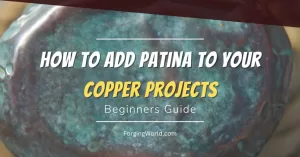Hey there, budding blacksmiths and curious crafters! Ever wondered about the mysterious world of metal heat treatment?
Maybe you’re asking yourself, “What’s the big deal about quenching?” or “Should I quench with a torch or forge?”
Well, you’re in the right place! We’re going to delve into the fascinating realm of quenching, compare torch quenching with forge quenching, and help you decide which method is best for you.
Let’s fire it up, shall we?
What is Quenching Anyway?
Quenching is an essential heat treatment process in metallurgy. It involves heating the metal and then rapidly cooling it to enhance its hardness and durability. You can perform quenching with a variety of tools and techniques, but today, we’re comparing two popular methods: torch quenching and forge quenching.
Forge Quenching: The Classic Method
Forge quenching is as traditional as it gets, like the stuff of historical blacksmiths. You heat your metal in a forge—a specially designed fireplace, essentially—then quench it in your preferred cooling liquid. For an in-depth look at why blacksmiths use different quenching liquids, check out this informative guide.
Advantages of Forge Quenching
- Even and consistent heating: A forge provides uniform heat, making it easier to control the temperature.
- Accommodates larger pieces: Have a big project? A forge can handle it!
Disadvantages of Forge Quenching
- It can be bulky: Forges take up space.
- It requires more fuel: Forges need substantial amounts of fuel, which can add up over time.
Torch Quenching: The Modern Touch
On the other hand, torch quenching is the more modern approach. Using a handheld torch—think of a really intense blowtorch—you heat the metal to the desired temperature and then cool it rapidly.
Advantages of Torch Quenching
- Mobility: The torch is portable and easy to move.
- Precise heating: You can target specific areas of the metal.
Disadvantages of Torch Quenching
- Uneven heating: It’s more challenging to achieve an even heat.
- Smaller size limitations: Larger projects might be tricky with a torch.
Torch or Forge: Which Quenching Technique is Right for You?
Pondering about the right quenching method for your blacksmithing or knife-making project? Both torch and forge quenching have their pros and cons.
Your choice ultimately boils down to your unique needs, project specifications, and the environment you’re working in. Let’s throw some more light on this to help you make an informed decision.
Ask yourself these questions:
- What’s the size of your projects? Forge quenching can accommodate larger pieces of metal, while torch quenching is typically used for smaller items.
- How much space do you have? A forge can be a bit bulky, so make sure you have enough room for it.
- What’s your fuel budget? Keep in mind, running a forge requires more fuel, which can impact your budget over time.
Now, here’s where those additional keywords come into play.
In terms of heating, a forge can take way too long for some. The process is slower compared to torch quenching, but it’s worth noting that it provides even and consistent heating. You can avoid any hot spots that can compromise the quality of your metalwork.
On the other hand, torch quenching might not be as accurate due to the small flame size. It’s a faster process, but you might find it difficult to evenly heat larger pieces. However, for jobs like an edge quench, where only a specific part of the blade needs to be hardened, a torch is a handy tool.
And while it might seem daunting, it is possible to master either technique with patience, practice, and the right information. For more in-depth understanding and safety tips on quenching, our comprehensive guide on how to quench a blade is a must-read.
Remember, the best quenching technique is the one that aligns with your project needs, personal preferences, and safety considerations.
Embracing the Heat: Fine-tuning Your Quenching Technique
Now that you’ve got a handle on the torch vs. forge debate, it’s time to focus on refining your technique. Both methods require a keen understanding of how heat interacts with metal. Here’s how to master both:
Mastering the Art of Forge Quenching
When working with a forge, start slow. Remember, your forge will heat your metal evenly, but it might take a bit more time. Patience is key here. Allow your piece to reach the critical temperature before plunging it into your quenching liquid. Remember to use tongs or pliers to hold your work; safety is paramount!
And speaking of quenching liquids, you might want to play around with different types. Check out our guide on the best quenching oils for knife making and blacksmithing for some insider tips!
Harnessing the Power of Torch Quenching
Torch quenching is a bit more of a free-hand technique. The key here is precision. You have to ensure your torch’s flame is evenly distributed across the area you want to harden. For tasks like edge quenching, a torch is the perfect tool.
Keep your torch moving to avoid hot spots and be careful not to overheat your metal. Remember, with torch quenching, you’re aiming for a glowing red heat, not white hot.
Wrapping it up: Your Journey to Becoming a Quenching Pro
There you have it, the complete lowdown on torch vs. forge quenching! From project size to fuel budget, heating speed to accuracy, we’ve covered all aspects to help you decide the best method for you. And let’s not forget the importance of your quenching liquid in achieving that perfect finish.
The choice between torch and forge quenching is ultimately yours to make. Each has its own unique advantages and possible challenges. With knowledge and practice, you’ll find the technique that fits your style and needs.
So, whether you’re a fan of the traditional forge quenching method or prefer the more modern torch quenching, there’s no stopping you now. Let your crafting journey begin.


